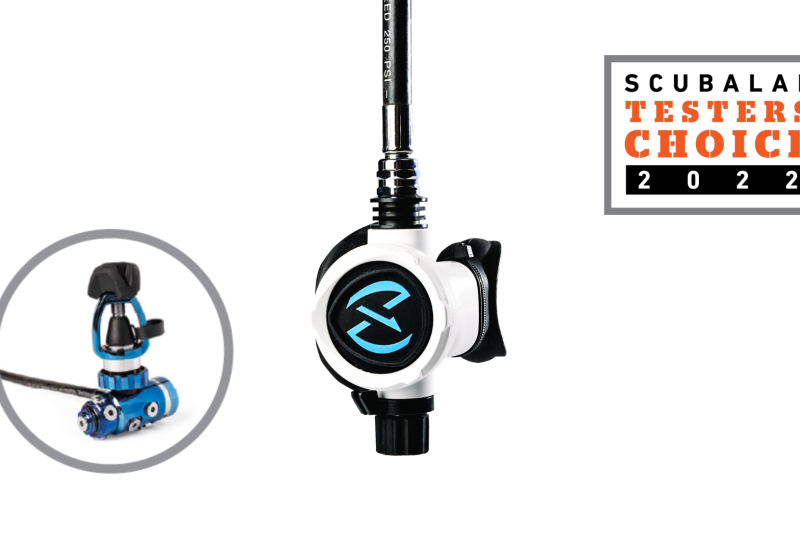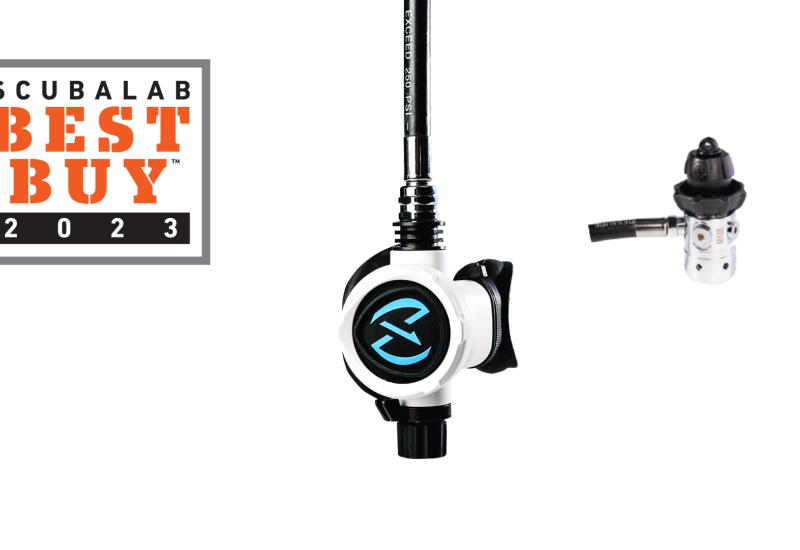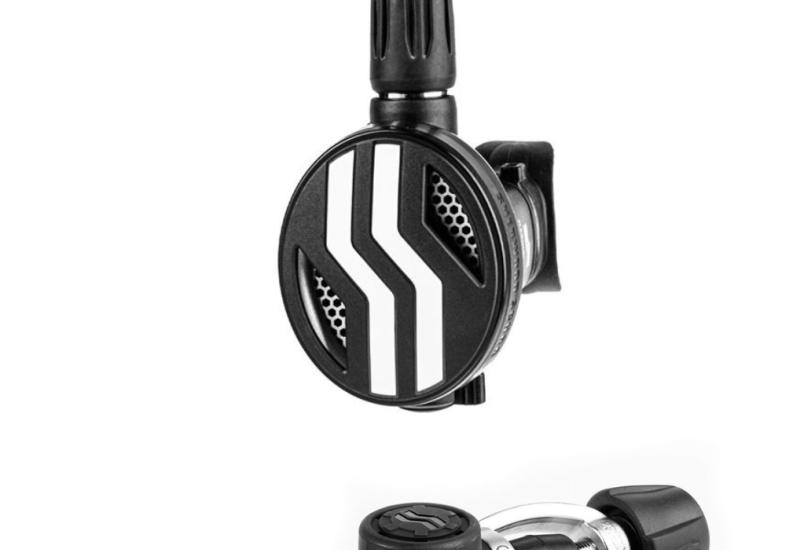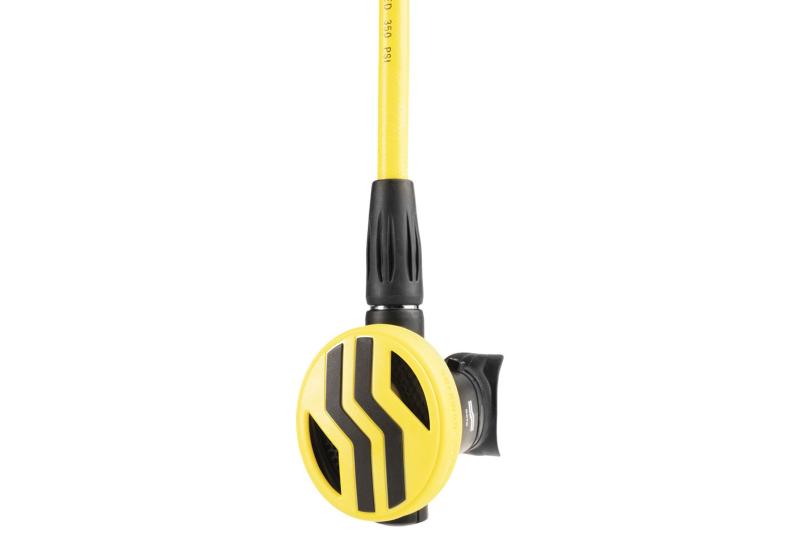7 Backup Breathers
August 2007
By Bill Kendig
Photography by Joseph Byrd
||
|---|
|

|
When divers choose an alternate inflator regulator, it's often with the thought of streamlining their gear, a laudable goal. What they may overlook is how well the combination of a BC power inflator and backup regulator performs all its critical functions when you need it most--an unplanned air-sharing situation.
As a backup breather, your inflator reg's breathing performance should be a prime consideration. After all, standard practice with these units is to hand your primary reg off to the diver in need while you switch to the backup. As with any air-sharing situation, you will also need to abort the dive by making a safe, controlled ascent, so the second thing to consider is how well the inflator reg allows you to control buoyancy both in normal circumstances and when you are breathing from it.
Good news: Our most recent test of alternate inflator regs (or octo-inflators as they are often called) shows that all of the following models can be counted on to perform at recreational dive depths and breathing rates. But we also found distinct differences, including two inflator regs that could handle the most extreme breathing tests we threw at them.
How We Tested Them
We invited all major manufacturers to submit their inflator regs for this review. After making sure all of the units were working properly, we headed to Panama City, Fla., and Dive Lab, an independent testing facility. We put the units on an ANSTI breathing simulator to measure their breathing resistance, or work of breathing (WOB). Each reg was subjected to a moderately high breathing rate (37.5 RMV) at depths of 132 feet and 165 feet. Then we cranked up the breathing rate to an extreme level (62.5 RMV), in order to see how much reserve capacity the regs had. To ensure an even playing field, all the inflator regs were tested on the same first stage with an intermediate pressure of 138 psi. And to make it challenging, we used a supply pressure between 725 and 760 psi. (For complete results, see the ANSTI breathing simulator chart.)
With the simulator results in hand, it was time to get real-world feedback from recreational divers in what we call our ergonomic tests. We assembled a team of eight volunteer divers and spent three days diving off Catalina Island, Calif., aboard the Island Time dive boat. During their dives, testers rated the performance of each inflator regulator in four categories: ease of breathing, dryness, ease of clearing and how well the inflator control functions worked. Using underwater slates and pre-printed score cards, each diver rated each inflator reg using a 1 to 5 scale (5=Excellent, 4=Very Good, 3= Good, 2=Fair, 1=Poor) and gave us written comments on how these inflator regs performed in the water. (For complete results, see the ergonomic performance chart.) As an added measure, we then polled the test divers with one final question, "Which one would you buy?" The inflator reg that received the most votes was awarded our Testers' Choice honor.
Here are the reviews, presented in alphabetical order.
Atomic Aquatics: SS1 Stainless
||||
|---|---|---|
|

|
| Atomic Aquatics: SS1 Stainless|
Features: "The SS1 is designed to replace your octopus, but its breathing performance may just put your primary second-stage regulator to shame. It's compact, light and built to last with 316 stainless-steel components housed in a fiberglass-reinforced nylon body. It features Atomic's Seat Saving Orifice, which helps maintain peak performance over time just like the company's primary regulators. It also has large, easy-to-use control buttons and a soft, oval purge cover that rests flat on your BC strap. The SS1 comes with an innovative adapter system that enables you to remove it easily from your BC's corrugated hose for cleaning and storage with your primary regulator. It carries a limited lifetime warranty and is nitrox-ready for mixes up to 50 percent oxygen.
Performance: "I almost forgot I wasn't using my primary" is how one test diver summarized the SS1's performance during our in-water testing. It was the only reg to earn any Excellent ratings from test divers--once for ease of breathing and again for user controls. "The buttons are easy to use even when it's in your mouth," commented one test diver. On the breathing simulator, the SS1 put up work of breathing numbers worthy of a primary regulator, earning Excellent ratings in three of the tests, and a Very Good in the most extreme breathing category--67.5 RMV at 165 feet.
Bottom Line: The SS1 is the top-of-the-line octo-inflator and our 2007 Testers' Choice. It's also the most expensive unit in this review, but worth every penny if you want the ultimate in performance.
Price: $249 for the stainless-steel version (model tested); $370 for the titanium version.
Dive Rite: Rite Source
||||
|---|---|---|
|

|
| Dive Rite: Rite Source|
Features: The Rite Source is a newcomer to the octo-inflator market. It's a low-profile, compact unit with a soft purge cover that's large and easy to find. The controls are well defined with the large, rectangular button for deflation and a small, round button for inflation. A standard-size mouthpiece with long bite tabs for better grip is a nice touch, but an even better one is the complete hose assembly including a 16-inch length of corrugated hose and a rapid exhaust valve. It's also compatible with nitrox mixes up to 40 percent.
Performance: Test divers rated the Rite Source Very Good in all four ergonomic categories. "It breathed smooth and dry in most positions," noted one diver, while another wrote, "the buttons were easy to recognize by feel." On the ANSTI machine, the Rite Source scored Very Good at a moderately aggressive breathing rate both at 132 feet and 165 feet.
Bottom Line: The Rite Source performed well in recreational circumstances. A real plus: The hose assembly is included as part of the deal.
Price: $199 (includes hose assembly).
H2Odyssey: Inflator Plus
||||
|---|---|---|
|

|
| H2Odyssey: Inflator Plus|
Features: The Inflator Plus looks like a carbon copy of the Rite Source, and the two units share identical features. It comes with the lowest suggested retail price ($127) of the units tested, and for $19 more you get a complete 19-inch hose assembly with rapid exhaust valve, which is the version we tested. The Inflator Plus carries a two-year warranty and is compatible with nitrox mixes up to 40 percent.
Performance: The Inflator Plus received Very Good ratings across the board in the ergonomic tests. The small, round inflate button and large, rectangular deflate button were easy to operate, and test divers liked the standard-size mouthpiece with longer tabs. The long corrugated hose is worth the extra money and "offers more range of movement." On the ANSTI machine, the Rite Source earned Very Good scores at a moderately aggressive breathing rate at both 132 feet and 165 feet.
Bottom Line: You can find better alternate inflator regs, but you won't find one with a lower price.
Price: $127; $148 with hose assembly.
Scubapro: AIR 2
||||
|---|---|---|
|

|
| Scubapro: AIR 2|
Features: Scubapro is the company that started it all, releasing the very first alternate inflator reg--the AIR--in 1979. The company has continued to refine its concept into what is now called the AIR 2. One of the most compact ergonomic designs of this test group, it's built from rugged fiberglass-reinforced nylon. The buttons are ergonomically correct and well positioned, making the unit easy to use. It also uses a fixed VIVA flow vane, pre-tuned in the ideal position to prevent surface free flows. The AIR 2 will fit any one-inch corrugated hose, and it comes from the factory nitrox-capable for mixes up to 40 percent oxygen.
Performance: The AIR 2 received Very Good scores from test divers for ease of breathing, dryness, clearing and control functions. Test divers said that as a regulator it "performed great in all positions," and as an inflator "it has it all--good button position, and it's easy to operate with gloves." The purge cover end is large and responsive when clearing. On the ANSTI breathing machine tests, it delivered Excellent performance when tested at the moderately aggressive breathing rate at both 132 feet and 165 feet.
Bottom Line: The AIR 2 has come a long way since the original and is still one of the most popular choices on the market.
Price: $215.
Sherwood Scuba: Gemini
||||
|---|---|---|
|

|
| Sherwood Scuba: Gemini|
Features: The Gemini is a new star among alternate inflator regs thanks to a combination of easy-breathing performance and well-designed controls. The slim, oval profile has a sizeable yellow deflate button and a smaller round inflate button for touch recognition. The lightweight composite housing is fitted with a standard-size mouthpiece that is replaceable. It's also nitrox-ready for mixes up to 40 percent oxygen.
Performance: According to both test divers and the ANSTI machine, this octo-inflator provided some of the best breathing performance among the regs in this review. "This is a very easy breather, as good as a primary," commented one tester. "Clears very well and stays dry," said another. On the ANSTI machine, the Gemini was one of only two inflator regs that survived all four of our tests. Based on its work-of-breathing numbers, we rated its performance as Excellent at a moderate breathing rate at 132 and 165 feet, Very Good at the extreme breathing rate at 132 feet, and Good for the extreme breathing rate at 165 feet. As an inflator, it fits nicely in the hand with distinctive control buttons for good touch recognition. The generous oval purge cover is easy to find and offered rapid clearing.
Bottom Line: The Gemini is a top performer with great breathing characteristics, great control features and a compact, streamlined design. It's a lot of reg for the money and earns our Best Buy recommendation.
Price: $200 (hose assembly not included).
Tusa: Duo-Air IR-3
||||
|---|---|---|
|

|
| Tusa: Duo-Air IR-3|
Features: The Duo-Air is a proven favorite with classic styling and compact design. It uses fiberglass-reinforced nylon for a light, durable case, and all internal parts are stainless steel or chrome-plated brass. The Duo-Air fits any one-inch-diameter corrugated hose, and it comes nitrox-ready for mixtures up to 40 percent.
Performance: The Duo-Air received Very Good scores in ergonomic performance for breathing, dryness, clearing and user controls. "This alternate inflator breathes like a primary," said one tester. The regulator breathed dry, and the mouthpiece is comfortable and replaceable. The unit fits well in the hand, leaving your thumb hovering over the buttons for quick adjustments. The purge button is "small but very sensitive," and good for clearing. On the ANSTI simulator the Duo-Air scored Excellent at a moderately aggressive breathing rate at depths of 132 feet and 165 feet.
Bottom Line: The Duo-Air is a proven performer that offers smooth and dry breathing within recreational diving limits and nice inflator controls.
Price: $220.
Zeagle: Octo-Z
||||
|---|---|---|
|

|
| Zeagle: Octo-Z|
Features: The Octo-Z is a newcomer to the market. It's compact, made of durable thermoplastic and has brightly colored control buttons. Zeagle has also made it easy to remove the Octo-Z from the corrugated hose by providing a threaded fitting. After you remove the unit, you can use the same threaded fitting to attach your garden hose to the BC to flush salt and sand out of the bladder. Your Octo-Z can then be stored with your primary regulator. Its threaded coupler will fit any corrugated hose with a one-inch diameter, and the unit comes factory-ready for nitrox mixes up to 40 percent oxygen.
Performance: Test divers found the reg to be an easy breather and reported that the inflator controls were easy to hold and operate. The Octo-Z also clears rapidly with just a touch of the big, soft purge cover. On the ANSTI machine, the Octo-Z turned in Excellent breathing scores at 132 feet and 165 feet using a moderately aggressive breathing rate. It was also one of only three units tested that performed well when pushed to the extreme breathing rate at 132 feet.
Bottom Line: The Octo-Z is a compact performer with breathing capacity to spare and innovative features at a competitive price.
Price: $198.
Octo-Inflator User's Guide
Here are a few things to consider when switching from a traditional octopus regulator to an inflator reg.
Hose length. The corrugated hose that connects your inflator reg to the BC needs to be long enough to allow a full range of movement. If you are upgrading your system and just buying the octo-inflator unit, the existing hose on your BC may not be long enough. Take your BC to the dive store and have a qualified technician fit the octo-inflator correctly and replace the hose if necessary. Some of the units tested come with (or offer as an add-on) a complete hose assembly with rapid exhaust dump--a good option that's well worth the money.
Ascent control. Proper ascent control is also an issue when using an octo-inflator. In a situation where your buddy needs air, you should offer your primary second stage and switch to your octo-inflator. This gives your buddy a long enough hose to maneuver and leaves you in control of your own buoyancy. The tricky part is venting air during your ascent. One way is to use the alternate pull dump found on the right shoulder of most jacket-style BCs. If you don't have this feature, then you may be able to pull down on the corrugated hose (another reason you need a long corrugated hose) to activate the rapid exhaust valve. Some manufacturers make hoses with a grip in the middle specifically for this purpose. The least desirable option would be to take the octo-inflator out of your mouth so you can press the deflation button and vent air from the BC. Because you are ascending, it is critical that you never hold your breath and risk lung overexpansion injuries. If you have to take the octo-inflator out of your mouth, make sure you are exhaling a constant stream of bubbles or making a continuous "ahhh" sound that indicates you are breathing out.
Practice the techniques. Discuss your options and the configuration of your BC with a trusted dive instructor, then practice in a controlled, nonemergency environment. Practice switching from your primary second stage to your octo-inflator. Make a normal slow ascent while controlling your buoyancy with the method you feel most comfortable with. Keep your primary second stage close at hand so you can switch back if you have any problems. Perform a slow (30 feet per minute) ascent up to 15 feet and then a normal three- to five-minute safety stop before final ascent. Try it first with your buddy watching, and once you have mastered the technique, practice with your buddy actually using your primary regulator.
Care & Maintenance Tips
Remember that in an emergency air-sharing situation, your life may depend on how well your octo-reg can deliver air. Follow these tips for trouble-free service.
Clean it. Follow all manufacturer recommendations for cleaning your inflator reg. That typically means soaking your octo-inflator under pressure, along with your primary regulator, for approximately 20 minutes in fresh water. Purge any residual water from the reg before depressurizing the system. If the unit detaches from the corrugated hose, store it with your primary regulator.
Protect it. The low-pressure seat, as well as the inflator valve should be protected from foreign material (sand, salt, silt) that could cause a free-flowing regulator or a stuck power inflator. When you detach the low-pressure hose, always use the protective cap to seal the valve opening.
Service it. Remember that in an air-sharing emergency, this is your backup reg. Give it the same care and annual maintenance you would give a traditional regulator.
How We Test Inflator Regulators
ANSTI Breathing Simulator
The ANSTI machine is the international industry standard for scientifically evaluating a regulator's performance. It measures a regulator's work of breathing (WOB) in joules per liter (j/l) for each complete inhale/exhale cycle. We test alternate inflator regulators at four different RMV/depth combinations (RMV stands for Respiratory Minute Volumes, basically the amount of gas that can be ventilated through the lungs in one minute). All simulator tests are performed at a supply pressure of 725-760 psi. If a regulator can perform well at this supply pressure, it will perform as well or better at higher supply pressures.
Column A 37.5 RMV @ 132 fsw: The maximum recreational depth at a moderately aggressive breathing rate.
Column B 37.5 RMV @ 165 fsw: The European Conformance (CE) standard test depth at a moderately aggressive breathing rate.
Column C 62.5 RMV @ 132 fsw: The maximum recreational depth at a heavy-work breathing rate.
Column D62.5 RMV @ 165 fsw: The CE standard test depth at a heavy-work breathing rate.
Our test parameters state that the highest inhale or exhalation pressure experienced by the "diver" should never exceed 25 millibars or a total WOB of 3 j/l. If a reg exceeds either parameter, it "fails" our test, but that doesn't mean that it stops delivering air--only that the breathing resistance at some point in the cycle is higher than what is common for most modern regulators.
A machine as accurate as the ANSTI simulator can accurately differentiate j/l measurements to tenths and even hundredths of a point. Human divers, however, can't. We've translated j/l scores into three basic classifications: Excellent, Very Good and Good. Here's what each score represents:
5=Excellent: Any inflator reg that can achieve the breathing rate/depth category with a WOB of 1.75 j/l or less.
4=Very Good: Any inflator reg that can achieve the breathing rate/depth category with a WOB of 2.5 j/l or less.
3=Good: Any inflator reg that can achieve the breathing rate/depth category with a WOB of less than 3.0 j/l (the EN250 limit).
When considering the ANSTI scores, pay particular attention to Columns A and B, since these are the tests that most closely approximate recreational use. Columns C and D are useful primarily in determining an inflator reg's reserve capacity.
Ergonomic Tests: The Human Factor
Breathing machines tell only half the story. To gauge the ergonomic traits of regulators, we use a minimum of six test divers. Each diver rates each reg for user friendliness in four areas:
Ease of breathing: How well does the inflator reg deliver air when the diver is propelling himself forward in the standard swimming position?
Dryness: During normal swimming and when in odd positions, does the inflator reg breathe wet or dry?
Ease of clearing: How difficult is it to find and use the purge? How dry is it after being cleared. How forceful is the purge? How much force is required to clear the regulator by exhaling?
User Controls: How easy is it to find and use the inflate/deflate buttons? Are the controls efficient?
Performance is recorded using numeric scores on a 1 to 5 scale (5=Excellent, 4=Very Good, 3=Good, 2=Fair, 1=Poor) and written comments.
Alternate Inflator Regulator Chart
| Price | $249 SS $370 Ti | $199* | $127/ $148* | $215 | $200 | $220 | $198/ $239* |
| Warranty | Ltd. Lifetime | Ltd. Lifetime | 2 years | Ltd. Lifetime | Ltd. Lifetime | Ltd. Lifetime | Ltd. Lifetime |
| Made In | USA | Taiwan | Taiwan | Italy | Taiwan | Italy | USA |
| Optimum Intermediate Pressure (in psi) | 125-145 | 140 | 135-145 | 120-160 | 125-155 | 160 Max | 130-150 |
| Factory-Ready Nitrox-Capable | Up to 50% | Up to 40% | Up to 40% | Up to 40% | Up to 40% | Up to 40% | Up to 40% |
| Test Diver Ratings Of Ergonomic Performance (5=Excellent 4=Very Good 3=Good 2=Fair 1=Poor) | |||||||
| Ease Of Breathing | 5 | 4 | 4 | 4 | 4 | 4 | 4 |
| Dryness | 4 | 4 | 4 | 4 | 4 | 4 | 4 |
| Clearing Blow/Purge | 4 | 4 | 4 | 4 | 4 | 4 | 4 |
| User Controls | 5 | 4 | 4 | 4 | 4 | 4 | 4 |
| ANSTI Breathing Simulator Results | |||||||
| A > 37.5 RMV @ 132 fsw | 5 | 4 | 4 | 5 | 5 | 5 | 5 |
| B > 37.5 RMV @ 165 fsw | 5 | 4 | 4 | 5 | 5 | 5 | 5 |
| C > 62.5 RMV @ 132 fsw | 5 | - | - | - | 4 | - | 4 |
| D > 62.5 RMV @ 165 fsw | 4 | - | - | - | 3 | - | - |
| Note: Blank spaces indicate that the regulator was not able to achieve the RMV/Depth category without exceeding the 25 milllibar test limits on either inhalation or exhalation, or exceeding a total Work of Breathing of 3 j/l. * Price with valve and corrugated hose assembly |
August 2007
By Bill Kendig
Photography by Joseph Byrd
|| |---|
|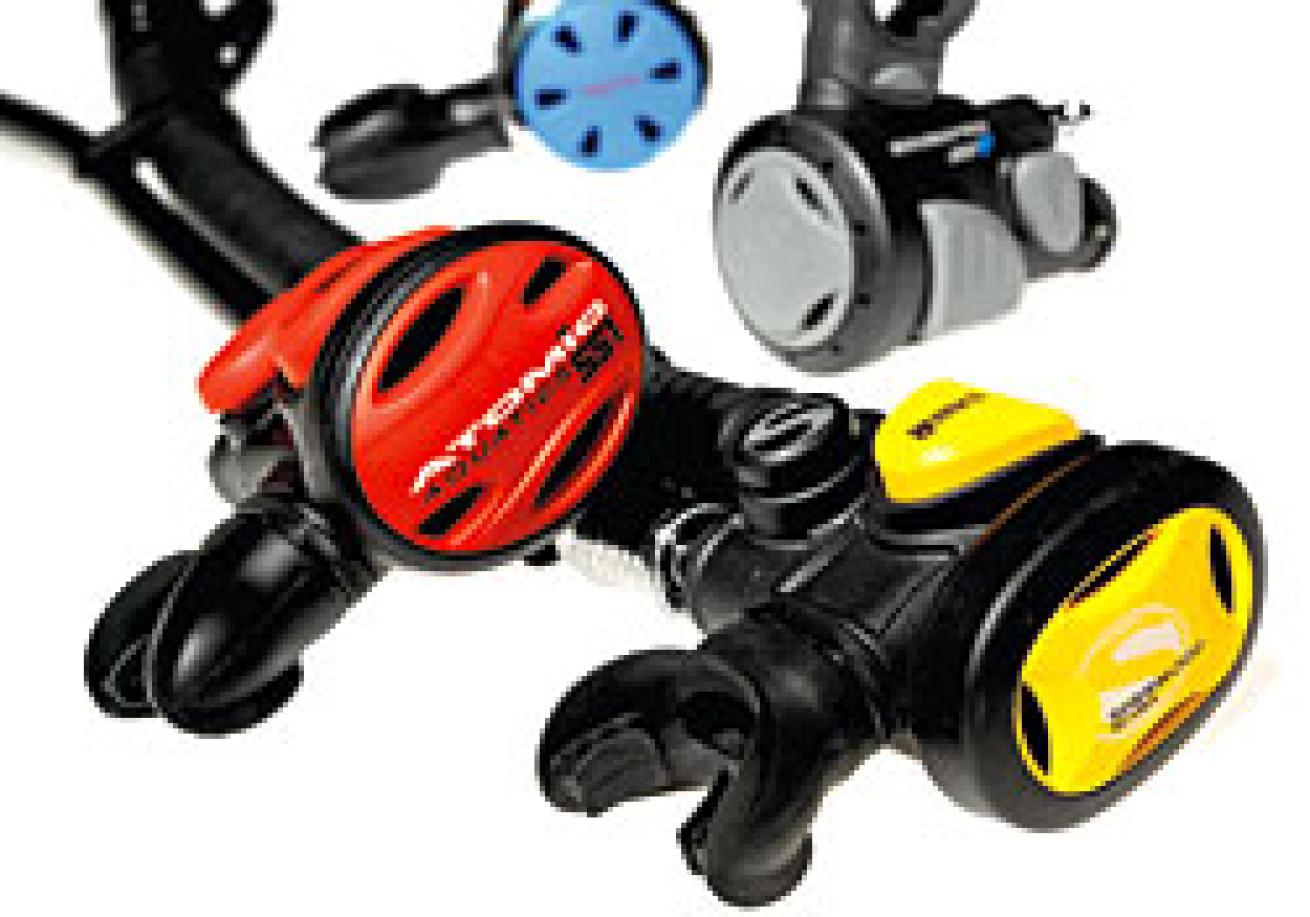
|
As a backup breather, your inflator reg's breathing performance should be a prime consideration. After all, standard practice with these units is to hand your primary reg off to the diver in need while you switch to the backup. As with any air-sharing situation, you will also need to abort the dive by making a safe, controlled ascent, so the second thing to consider is how well the inflator reg allows you to control buoyancy both in normal circumstances and when you are breathing from it.
Good news: Our most recent test of alternate inflator regs (or octo-inflators as they are often called) shows that all of the following models can be counted on to perform at recreational dive depths and breathing rates. But we also found distinct differences, including two inflator regs that could handle the most extreme breathing tests we threw at them.
How We Tested Them
We invited all major manufacturers to submit their inflator regs for this review. After making sure all of the units were working properly, we headed to Panama City, Fla., and Dive Lab, an independent testing facility. We put the units on an ANSTI breathing simulator to measure their breathing resistance, or work of breathing (WOB). Each reg was subjected to a moderately high breathing rate (37.5 RMV) at depths of 132 feet and 165 feet. Then we cranked up the breathing rate to an extreme level (62.5 RMV), in order to see how much reserve capacity the regs had. To ensure an even playing field, all the inflator regs were tested on the same first stage with an intermediate pressure of 138 psi. And to make it challenging, we used a supply pressure between 725 and 760 psi. (For complete results, see the ANSTI breathing simulator chart.)
With the simulator results in hand, it was time to get real-world feedback from recreational divers in what we call our ergonomic tests. We assembled a team of eight volunteer divers and spent three days diving off Catalina Island, Calif., aboard the Island Time dive boat. During their dives, testers rated the performance of each inflator regulator in four categories: ease of breathing, dryness, ease of clearing and how well the inflator control functions worked. Using underwater slates and pre-printed score cards, each diver rated each inflator reg using a 1 to 5 scale (5=Excellent, 4=Very Good, 3= Good, 2=Fair, 1=Poor) and gave us written comments on how these inflator regs performed in the water. (For complete results, see the ergonomic performance chart.) As an added measure, we then polled the test divers with one final question, "Which one would you buy?" The inflator reg that received the most votes was awarded our Testers' Choice honor.
Here are the reviews, presented in alphabetical order.
Atomic Aquatics: SS1 Stainless
|||| |---|---|---|
|<
table>
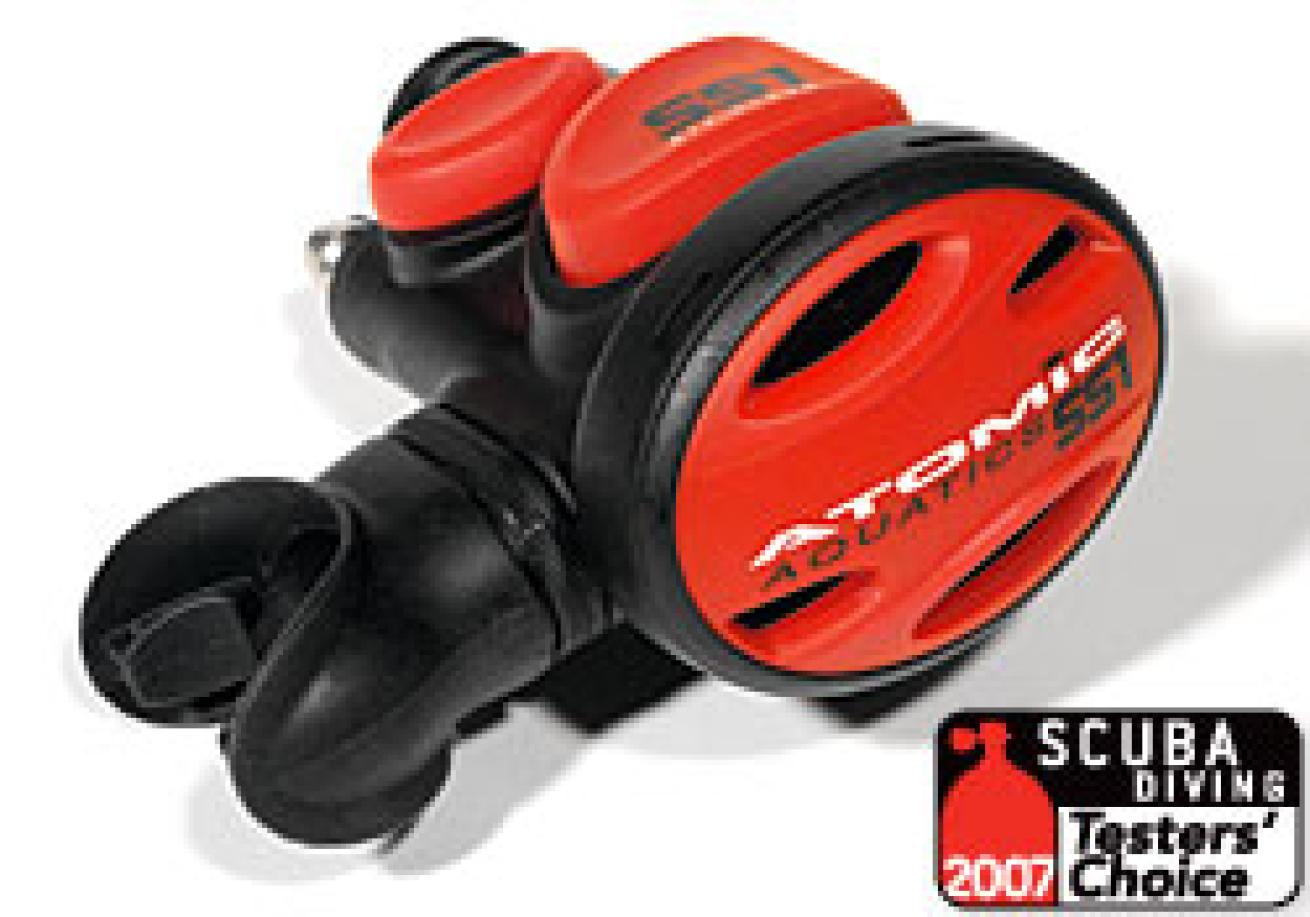
| | Atomic Aquatics: SS1 Stainless|
Performance: "I almost forgot I wasn't using my primary" is how one test diver summarized the SS1's performance during our in-water testing. It was the only reg to earn any Excellent ratings from test divers--once for ease of breathing and again for user controls. "The buttons are easy to use even when it's in your mouth," commented one test diver. On the breathing simulator, the SS1 put up work of breathing numbers worthy of a primary regulator, earning Excellent ratings in three of the tests, and a Very Good in the most extreme breathing category--67.5 RMV at 165 feet.
Bottom Line: The SS1 is the top-of-the-line octo-inflator and our 2007 Testers' Choice. It's also the most expensive unit in this review, but worth every penny if you want the ultimate in performance.
Price: $249 for the stainless-steel version (model tested); $370 for the titanium version.
Dive Rite: Rite Source
|||| |---|---|---|
|<
table>
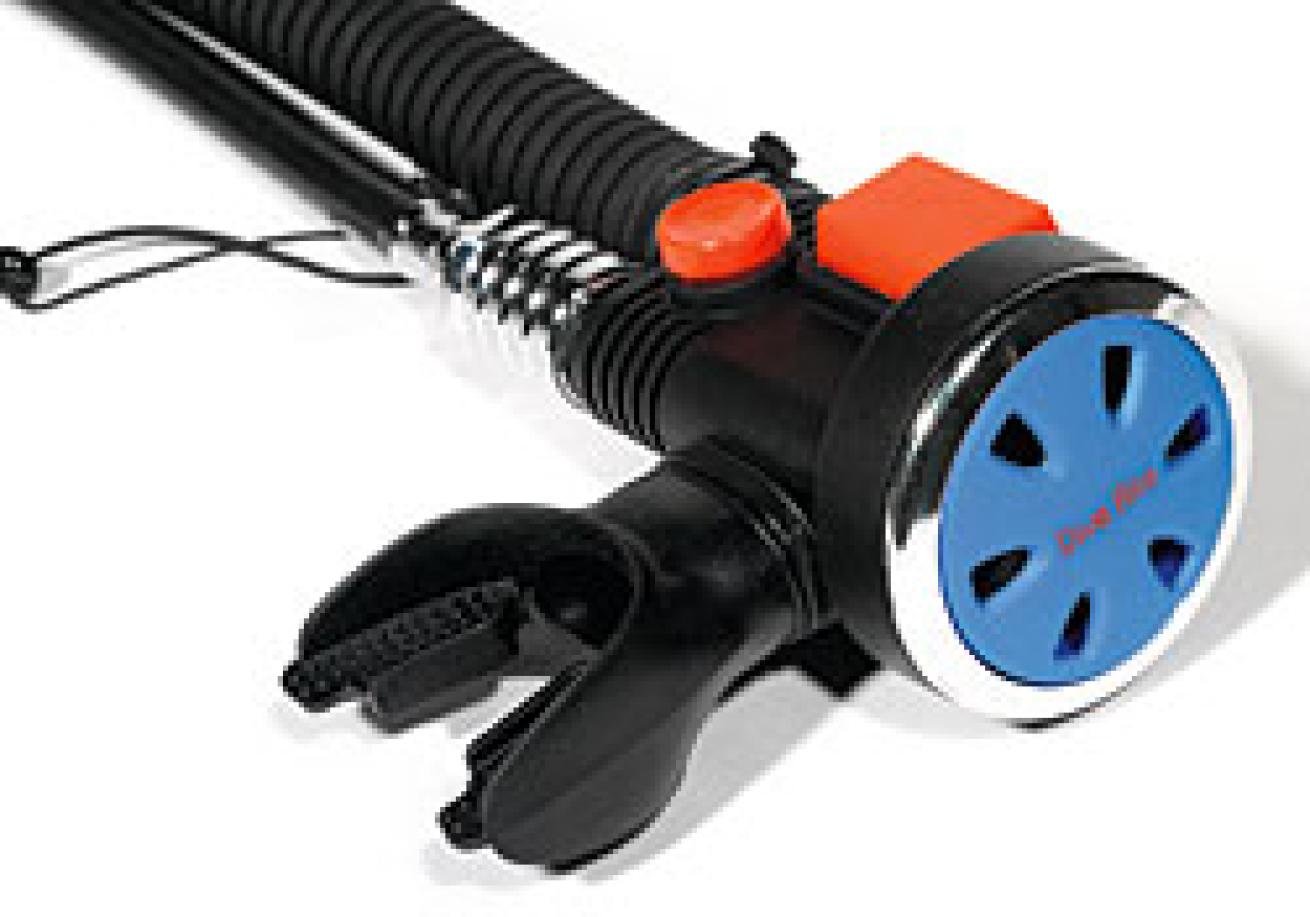
| | Dive Rite: Rite Source|
Performance: Test divers rated the Rite Source Very Good in all four ergonomic categories. "It breathed smooth and dry in most positions," noted one diver, while another wrote, "the buttons were easy to recognize by feel." On the ANSTI machine, the Rite Source scored Very Good at a moderately aggressive breathing rate both at 132 feet and 165 feet.
Bottom Line: The Rite Source performed well in recreational circumstances. A real plus: The hose assembly is included as part of the deal.
Price: $199 (includes hose assembly).
H2Odyssey: Inflator Plus
|||| |---|---|---|
|<
table>
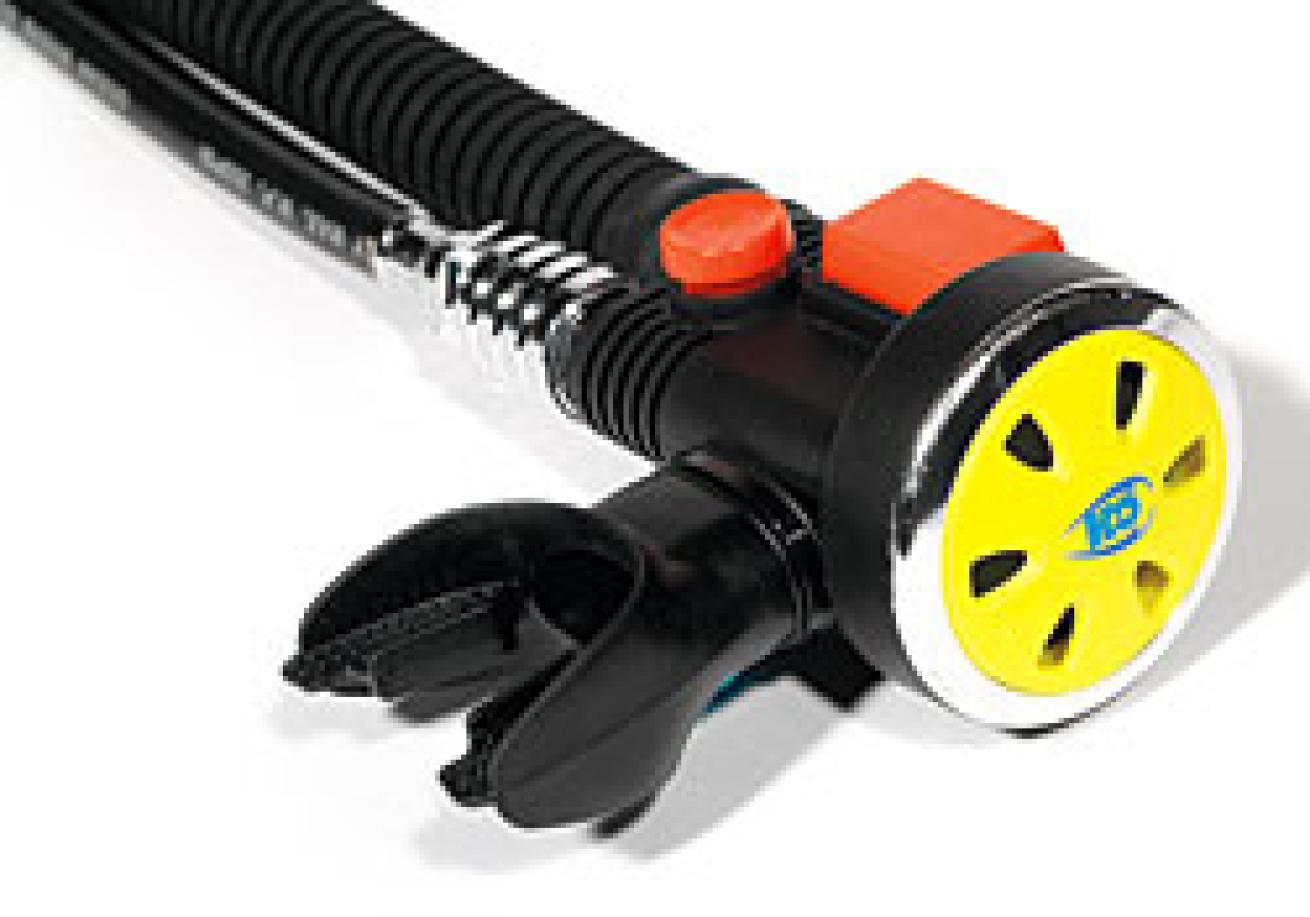
| | H2Odyssey: Inflator Plus|
Performance: The Inflator Plus received Very Good ratings across the board in the ergonomic tests. The small, round inflate button and large, rectangular deflate button were easy to operate, and test divers liked the standard-size mouthpiece with longer tabs. The long corrugated hose is worth the extra money and "offers more range of movement." On the ANSTI machine, the Rite Source earned Very Good scores at a moderately aggressive breathing rate at both 132 feet and 165 feet.
Bottom Line: You can find better alternate inflator regs, but you won't find one with a lower price.
Price: $127; $148 with hose assembly.
Scubapro: AIR 2
|||| |---|---|---|
|<
table>
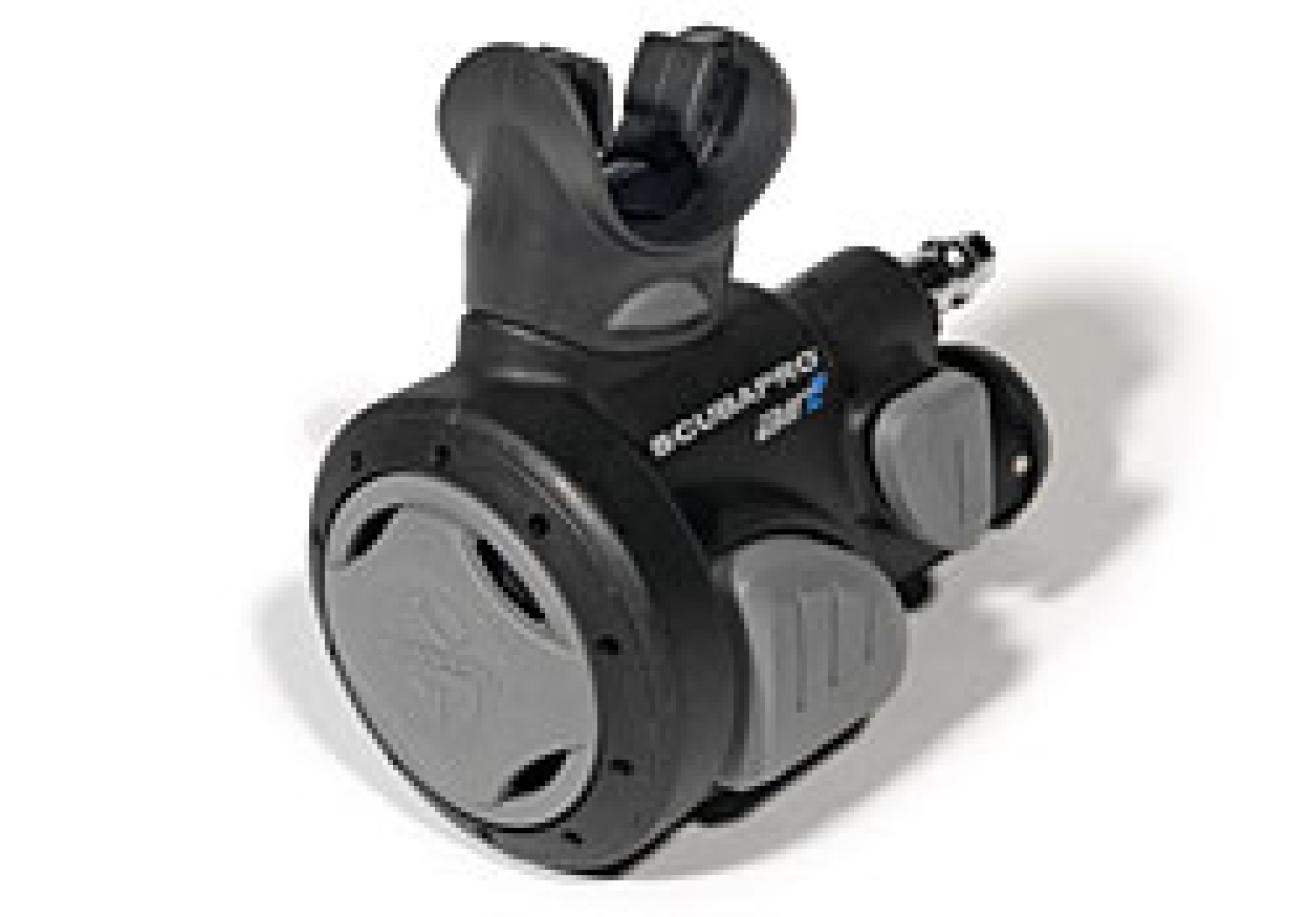
| | Scubapro: AIR 2|
Performance: The AIR 2 received Very Good scores from test divers for ease of breathing, dryness, clearing and control functions. Test divers said that as a regulator it "performed great in all positions," and as an inflator "it has it all--good button position, and it's easy to operate with gloves." The purge cover end is large and responsive when clearing. On the ANSTI breathing machine tests, it delivered Excellent performance when tested at the moderately aggressive breathing rate at both 132 feet and 165 feet.
Bottom Line: The AIR 2 has come a long way since the original and is still one of the most popular choices on the market.
Price: $215.
Sherwood Scuba: Gemini
|||| |---|---|---|
|<
table>
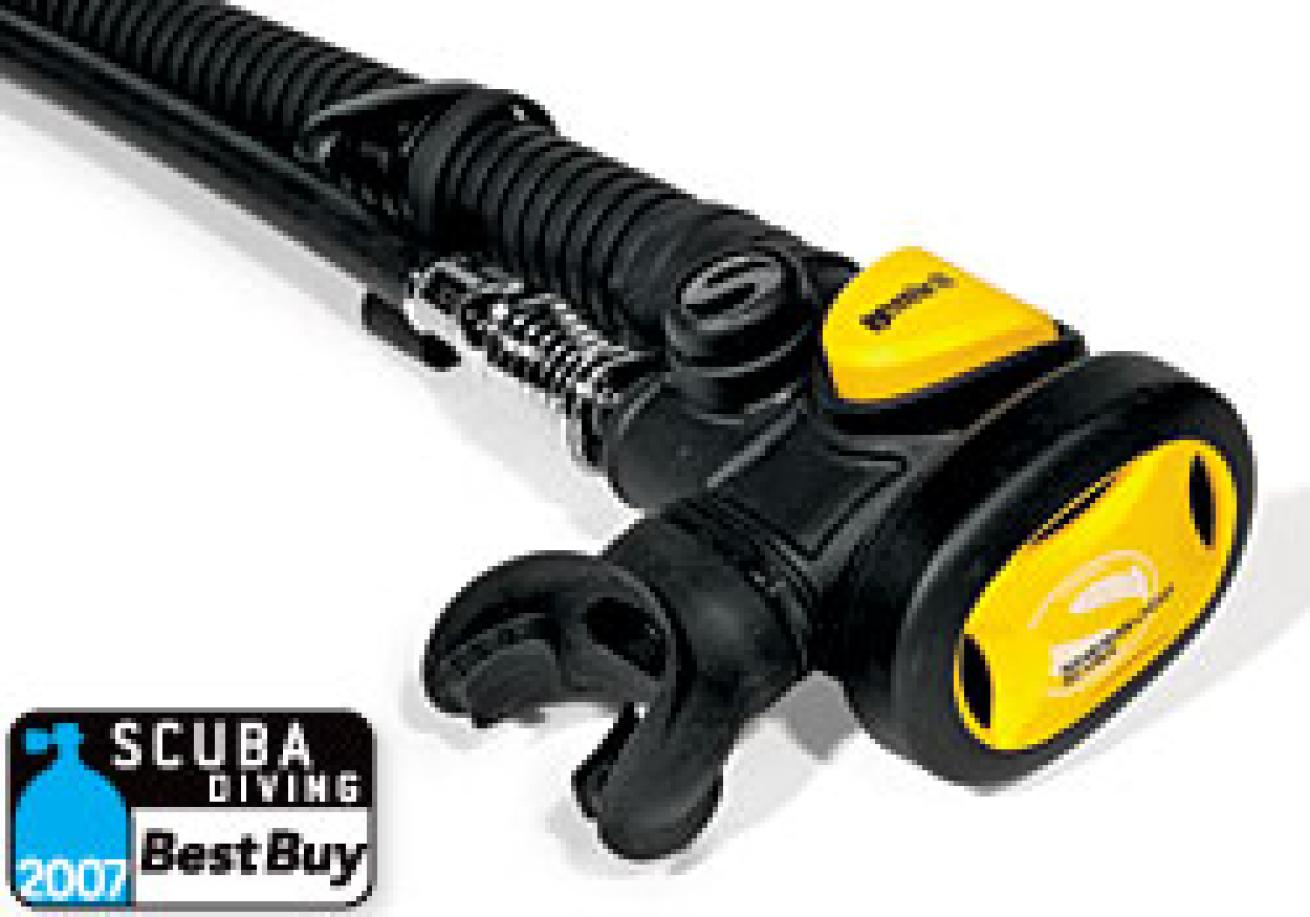
| | Sherwood Scuba: Gemini|
Performance: According to both test divers and the ANSTI machine, this octo-inflator provided some of the best breathing performance among the regs in this review. "This is a very easy breather, as good as a primary," commented one tester. "Clears very well and stays dry," said another. On the ANSTI machine, the Gemini was one of only two inflator regs that survived all four of our tests. Based on its work-of-breathing numbers, we rated its performance as Excellent at a moderate breathing rate at 132 and 165 feet, Very Good at the extreme breathing rate at 132 feet, and Good for the extreme breathing rate at 165 feet. As an inflator, it fits nicely in the hand with distinctive control buttons for good touch recognition. The generous oval purge cover is easy to find and offered rapid clearing.
Bottom Line: The Gemini is a top performer with great breathing characteristics, great control features and a compact, streamlined design. It's a lot of reg for the money and earns our Best Buy recommendation.
Price: $200 (hose assembly not included).
Tusa: Duo-Air IR-3
|||| |---|---|---|
|<
table>
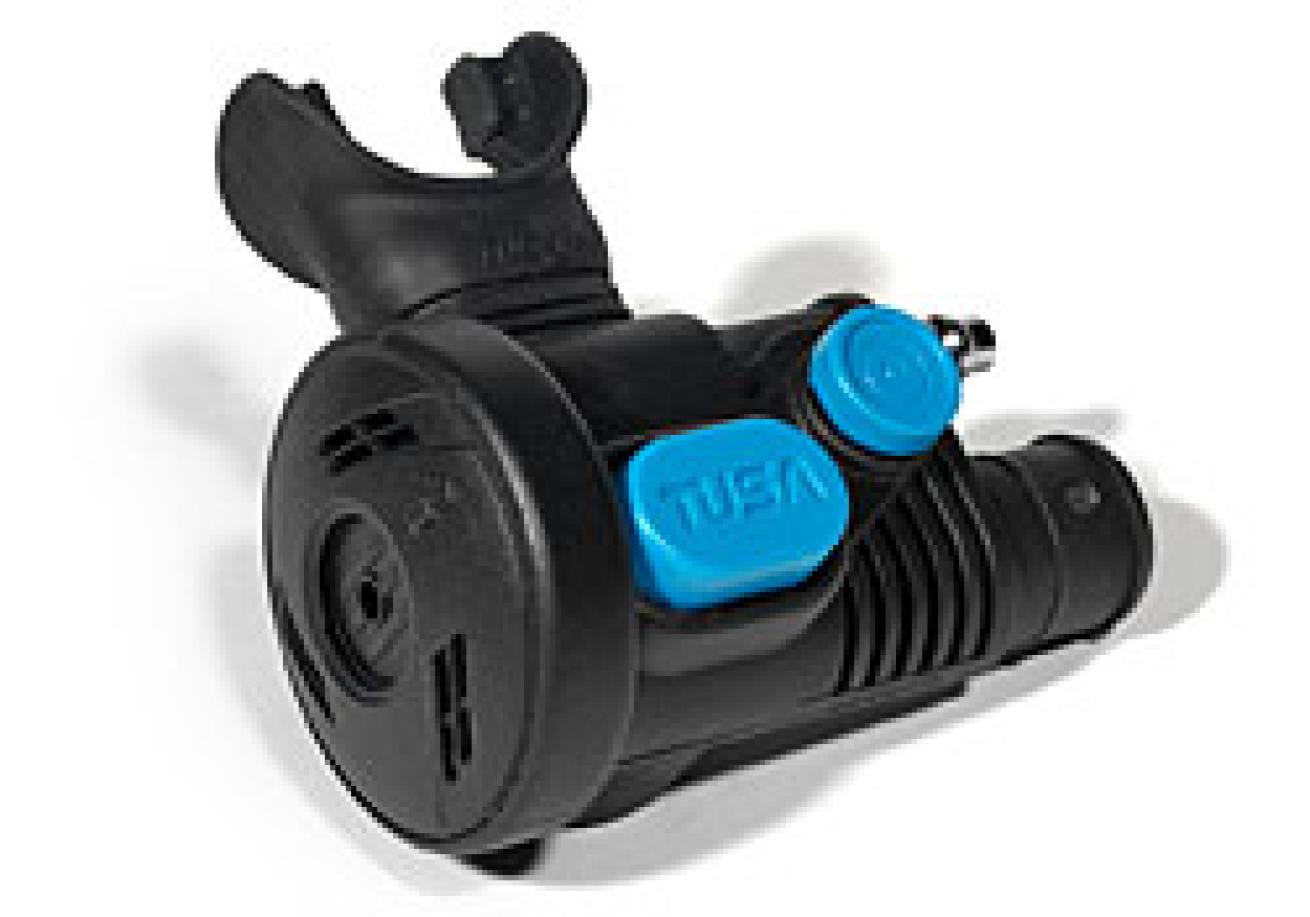
| | Tusa: Duo-Air IR-3|
Performance: The Duo-Air received Very Good scores in ergonomic performance for breathing, dryness, clearing and user controls. "This alternate inflator breathes like a primary," said one tester. The regulator breathed dry, and the mouthpiece is comfortable and replaceable. The unit fits well in the hand, leaving your thumb hovering over the buttons for quick adjustments. The purge button is "small but very sensitive," and good for clearing. On the ANSTI simulator the Duo-Air scored Excellent at a moderately aggressive breathing rate at depths of 132 feet and 165 feet.
Bottom Line: The Duo-Air is a proven performer that offers smooth and dry breathing within recreational diving limits and nice inflator controls.
Price: $220.
Zeagle: Octo-Z
|||| |---|---|---|
|<
table>
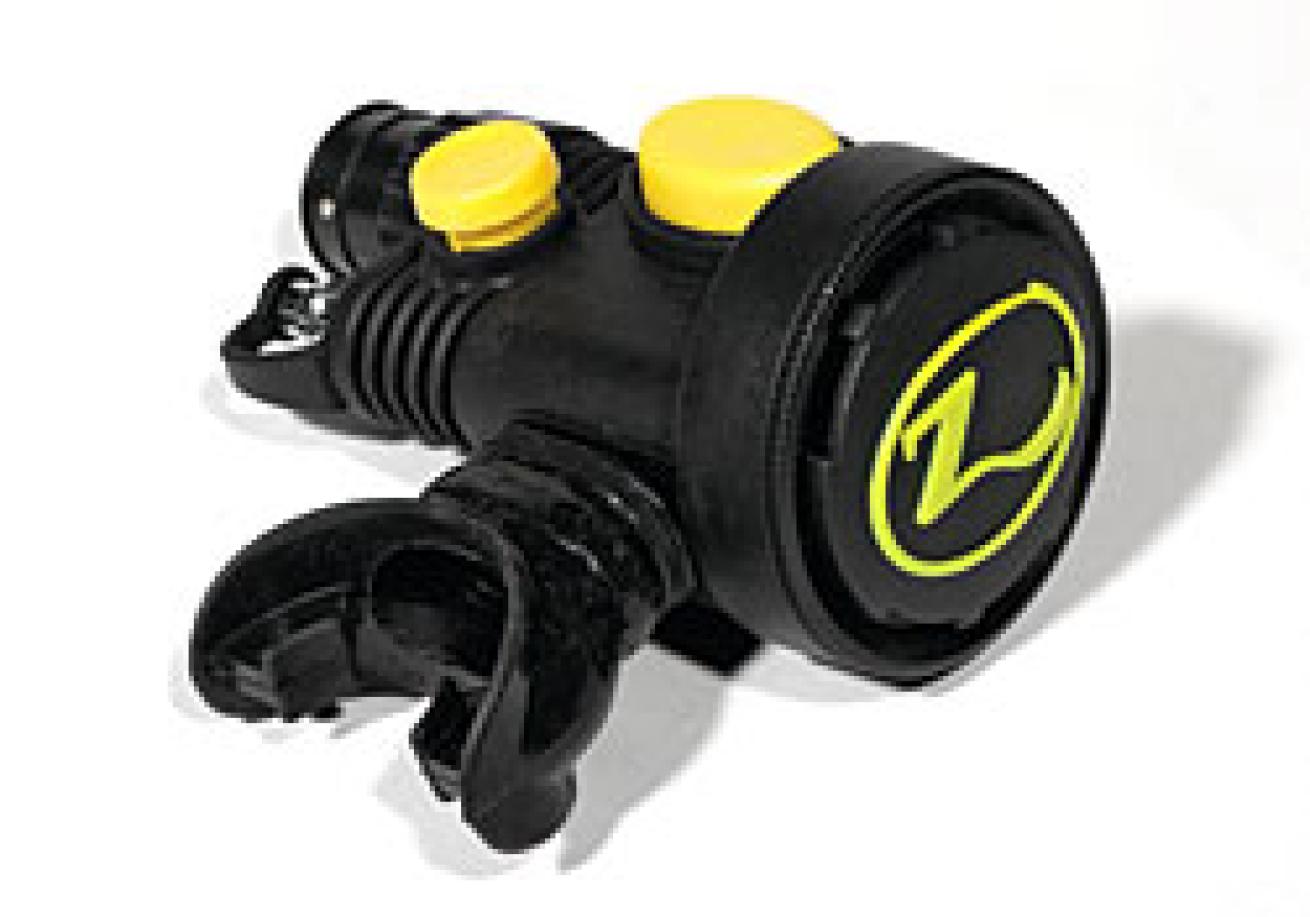
| | Zeagle: Octo-Z|
Performance: Test divers found the reg to be an easy breather and reported that the inflator controls were easy to hold and operate. The Octo-Z also clears rapidly with just a touch of the big, soft purge cover. On the ANSTI machine, the Octo-Z turned in Excellent breathing scores at 132 feet and 165 feet using a moderately aggressive breathing rate. It was also one of only three units tested that performed well when pushed to the extreme breathing rate at 132 feet.
Bottom Line: The Octo-Z is a compact performer with breathing capacity to spare and innovative features at a competitive price.
Price: $198.
Octo-Inflator User's Guide
Here are a few things to consider when switching from a traditional octopus regulator to an inflator reg.
Hose length. The corrugated hose that connects your inflator reg to the BC needs to be long enough to allow a full range of movement. If you are upgrading your system and just buying the octo-inflator unit, the existing hose on your BC may not be long enough. Take your BC to the dive store and have a qualified technician fit the octo-inflator correctly and replace the hose if necessary. Some of the units tested come with (or offer as an add-on) a complete hose assembly with rapid exhaust dump--a good option that's well worth the money.
Ascent control. Proper ascent control is also an issue when using an octo-inflator. In a situation where your buddy needs air, you should offer your primary second stage and switch to your octo-inflator. This gives your buddy a long enough hose to maneuver and leaves you in control of your own buoyancy. The tricky part is venting air during your ascent. One way is to use the alternate pull dump found on the right shoulder of most jacket-style BCs. If you don't have this feature, then you may be able to pull down on the corrugated hose (another reason you need a long corrugated hose) to activate the rapid exhaust valve. Some manufacturers make hoses with a grip in the middle specifically for this purpose. The least desirable option would be to take the octo-inflator out of your mouth so you can press the deflation button and vent air from the BC. Because you are ascending, it is critical that you never hold your breath and risk lung overexpansion injuries. If you have to take the octo-inflator out of your mouth, make sure you are exhaling a constant stream of bubbles or making a continuous "ahhh" sound that indicates you are breathing out.
Practice the techniques. Discuss your options and the configuration of your BC with a trusted dive instructor, then practice in a controlled, nonemergency environment. Practice switching from your primary second stage to your octo-inflator. Make a normal slow ascent while controlling your buoyancy with the method you feel most comfortable with. Keep your primary second stage close at hand so you can switch back if you have any problems. Perform a slow (30 feet per minute) ascent up to 15 feet and then a normal three- to five-minute safety stop before final ascent. Try it first with your buddy watching, and once you have mastered the technique, practice with your buddy actually using your primary regulator.
Care & Maintenance Tips
Remember that in an emergency air-sharing situation, your life may depend on how well your octo-reg can deliver air. Follow these tips for trouble-free service.
Clean it. Follow all manufacturer recommendations for cleaning your inflator reg. That typically means soaking your octo-inflator under pressure, along with your primary regulator, for approximately 20 minutes in fresh water. Purge any residual water from the reg before depressurizing the system. If the unit detaches from the corrugated hose, store it with your primary regulator.
Protect it. The low-pressure seat, as well as the inflator valve should be protected from foreign material (sand, salt, silt) that could cause a free-flowing regulator or a stuck power inflator. When you detach the low-pressure hose, always use the protective cap to seal the valve opening.
Service it. Remember that in an air-sharing emergency, this is your backup reg. Give it the same care and annual maintenance you would give a traditional regulator.
How We Test Inflator Regulators
ANSTI Breathing Simulator
The ANSTI machine is the international industry standard for scientifically evaluating a regulator's performance. It measures a regulator's work of breathing (WOB) in joules per liter (j/l) for each complete inhale/exhale cycle. We test alternate inflator regulators at four different RMV/depth combinations (RMV stands for Respiratory Minute Volumes, basically the amount of gas that can be ventilated through the lungs in one minute). All simulator tests are performed at a supply pressure of 725-760 psi. If a regulator can perform well at this supply pressure, it will perform as well or better at higher supply pressures.
Column A 37.5 RMV @ 132 fsw: The maximum recreational depth at a moderately aggressive breathing rate.
Column B 37.5 RMV @ 165 fsw: The European Conformance (CE) standard test depth at a moderately aggressive breathing rate.
Column C 62.5 RMV @ 132 fsw: The maximum recreational depth at a heavy-work breathing rate.
Column D62.5 RMV @ 165 fsw: The CE standard test depth at a heavy-work breathing rate.
Our test parameters state that the highest inhale or exhalation pressure experienced by the "diver" should never exceed 25 millibars or a total WOB of 3 j/l. If a reg exceeds either parameter, it "fails" our test, but that doesn't mean that it stops delivering air--only that the breathing resistance at some point in the cycle is higher than what is common for most modern regulators.
A machine as accurate as the ANSTI simulator can accurately differentiate j/l measurements to tenths and even hundredths of a point. Human divers, however, can't. We've translated j/l scores into three basic classifications: Excellent, Very Good and Good. Here's what each score represents:
5=Excellent: Any inflator reg that can achieve the breathing rate/depth category with a WOB of 1.75 j/l or less.
4=Very Good: Any inflator reg that can achieve the breathing rate/depth category with a WOB of 2.5 j/l or less.
3=Good: Any inflator reg that can achieve the breathing rate/depth category with a WOB of less than 3.0 j/l (the EN250 limit).
When considering the ANSTI scores, pay particular attention to Columns A and B, since these are the tests that most closely approximate recreational use. Columns C and D are useful primarily in determining an inflator reg's reserve capacity.
Ergonomic Tests: The Human Factor
Breathing machines tell only half the story. To gauge the ergonomic traits of regulators, we use a minimum of six test divers. Each diver rates each reg for user friendliness in four areas:
Ease of breathing: How well does the inflator reg deliver air when the diver is propelling himself forward in the standard swimming position?
Dryness: During normal swimming and when in odd positions, does the inflator reg breathe wet or dry?
Ease of clearing: How difficult is it to find and use the purge? How dry is it after being cleared. How forceful is the purge? How much force is required to clear the regulator by exhaling?
User Controls: How easy is it to find and use the inflate/deflate buttons? Are the controls efficient?
Performance is recorded using numeric scores on a 1 to 5 scale (5=Excellent, 4=Very Good, 3=Good, 2=Fair, 1=Poor) and written comments.
Alternate Inflator Regulator Chart
||||||||| |---|---|---|---|---|---|---|---|
| | | | | | | | | | | | Price| $249 SS $370 Ti| $199*| $127/ $148*| $215| $200| $220| $198/ $239*| | Warranty| Ltd. Lifetime| Ltd. Lifetime| 2 years| Ltd. Lifetime| Ltd. Lifetime| Ltd. Lifetime| Ltd. Lifetime| | Made In| USA| Taiwan| Taiwan| Italy| Taiwan| Italy| USA| | Optimum Intermediate Pressure (in psi)| 125-145| 140| 135-145| 120-160| 125-155| 160 Max| 130-150| | Factory-Ready Nitrox-Capable| Up to 50%| Up to 40%| Up to 40%| Up to 40%| Up to 40%| Up to 40%| Up to 40%| | Test Diver Ratings Of Ergonomic Performance (5=Excellent 4=Very Good 3=Good 2=Fair 1=Poor)| | Ease Of Breathing| 5| 4| 4| 4| 4| 4| 4| | Dryness| 4| 4| 4| 4| 4| 4| 4| | Clearing Blow/Purge| 4| 4| 4| 4| 4| 4| 4| | User Controls| 5| 4| 4| 4| 4| 4| 4| | ANSTI Breathing Simulator Results| | A > 37.5 RMV @ 132 fsw| 5| 4| 4| 5| 5| 5| 5| | B > 37.5 RMV @ 165 fsw| 5| 4| 4| 5| 5| 5| 5| | C > 62.5 RMV @ 132 fsw| 5| -| -| -| 4| -| 4| | D > 62.5 RMV @ 165 fsw| 4| -| -| -| 3| -| -| | Note: Blank spaces indicate that the regulator was not able to achieve the RMV/Depth category without exceeding the 25 milllibar test limits on either inhalation or exhalation, or exceeding a total Work of Breathing of 3 j/l. * Price with valve and corrugated hose assembly|
